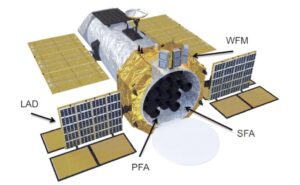The enhanced X-ray Timing and Polarimetry mission (eXTP) is a Chinese-European science mission designed to study the state of matter under extreme conditions of density, gravity and magnetism.
The primary goals are the determination of the equation of state of matter at supra-nuclear density, the measurement of QED effects in highly magnetized star, and the study of accretion in the strong-field regime of gravity. Primary targets include isolated and binary neutron stars, strong magnetic field systems like magnetars, and stellar-mass and supermassive black holes.

The mission carries a unique and unprecedented suite of state-of-the-art scientific instruments enabling for the first time ever the simultaneous spectral-timing-polarimetry studies of cosmic sources in the energy range from 0.5–30 keV (and beyond). Key elements of the payload are:
- the Spectroscopic Focusing Array (SFA): a set of 9 X-ray optics operating in the 0.5-10 keV energy band with a field-of-view (FoV) of 12 arcmin each and a total effective area of ∼0.8 m2 and 0.5 m2 at 2 keV and 6 keV respectively. The telescopes are equipped with Silicon Drift Detectors offering <180 eV spectral resolution.
- the Large Area Detector (LAD): a deployable set of 640 Silicon Drift Detectors, achieving a total effective area of ∼3.4 m2 between 6 and 10 keV. The operational energy range is 2-30 keV and the achievable spectral resolution better than 250 eV. This is a non-imaging instrument, with the FoV limited to <1° FWHM by the usage of compact capillary plates.
- the Polarimetry Focusing Array (PFA): a set of 4 X-ray telescope, achieving a total effective area of 900 cm2 at 2 keV, equipped with imaging gas pixel photoelectric polarimeters. The FoV of each telescope is 12 arcmin and the operating energy range is 2-10 keV.
- the Wide Field Monitor (WFM): a set of 3 coded mask wide field units, equipped with position-sensitive Silicon Drift Detectors, covering in total a FoV of 3.7 sr and operating in the energy range 2-50 keV.
The eXTP international consortium includes major institutions of the Chinese Academy of Sciences and Universities in China, as well as major institutions in several European countries and other Internatinal partners.
eXTP is an enhanced mission concept based on the XTP mission, enabled by the collaboration between Chinese and European institutions. The planned launch date of the mission is 2027.
INAF/OAS-Bologna is involved in this mission with key roles in the instrumental simulations of the LAD and WFM detectors (R. Campana), on the laboratory testing of Silicon Drift Detectors and their readout electronics (R. Campana, F. Fuschino, E. Virgilli) and on the thermal simulations (G. Morgante).
For more informations: https://www.isdc.unige.ch/extp/
